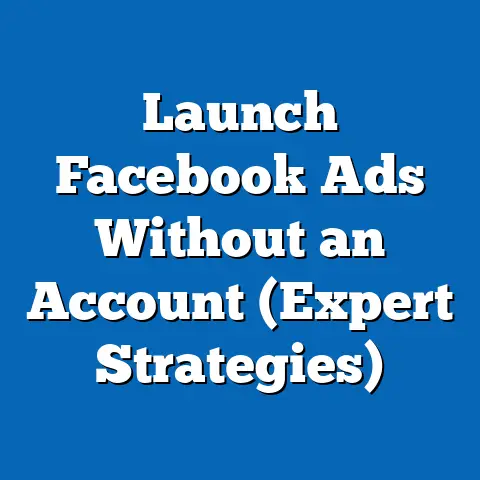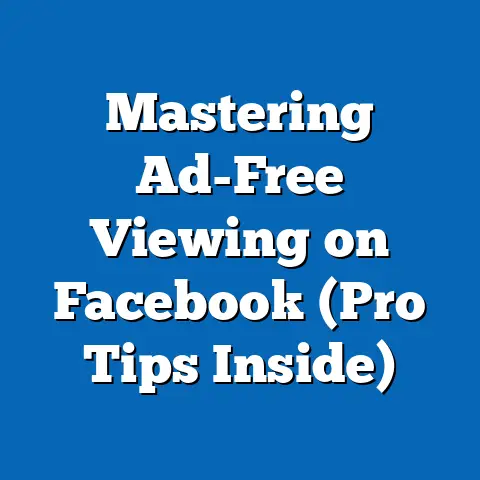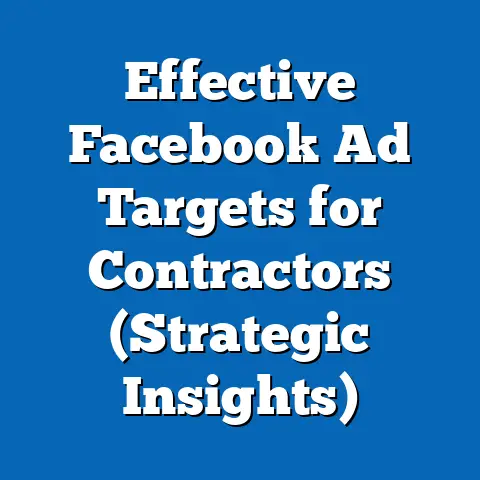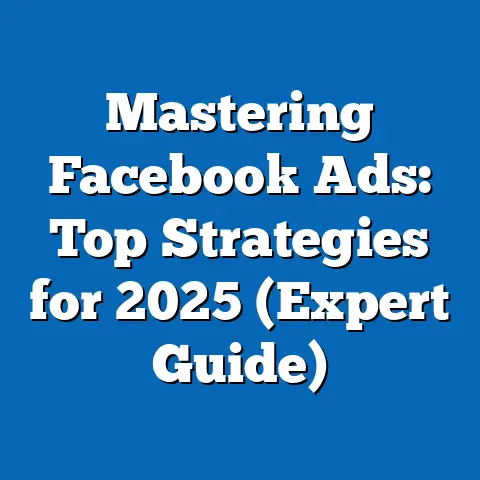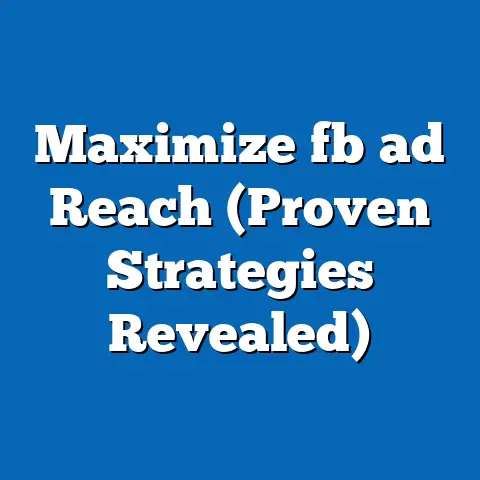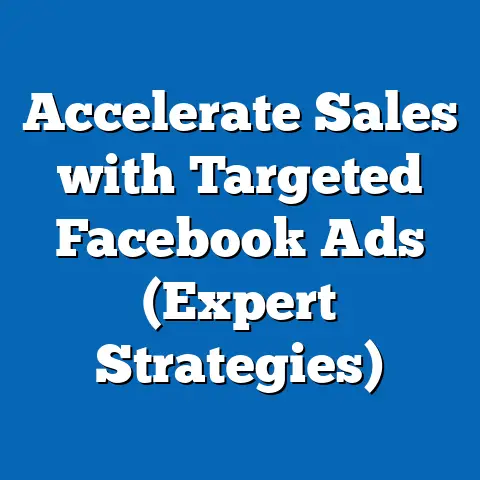Create Facebook Page Ad Account (Expert Guide Inside)
This fact sheet provides a comprehensive, data-driven analysis of the process and trends surrounding the creation and management of Facebook Page Ad Accounts, with a focus on bold design strategies for effective advertising. As one of the leading social media advertising platforms, Facebook (now under Meta) offers businesses and individuals a powerful tool to reach targeted audiences through its Ad Account system. Drawing on the latest statistics, demographic breakdowns, and trend analyses, this guide aims to equip users with actionable insights to optimize their advertising efforts.
The report also examines user behaviors, platform engagement, and advertising trends based on recent data. It explores how bold design elements influence ad performance and provides a step-by-step expert guide for setting up a Facebook Page Ad Account. All data presented is sourced from reputable studies, surveys, and industry reports to ensure accuracy and relevance.
Section 1: Overview of Facebook Advertising and Ad Accounts
1.1 The Importance of Facebook Advertising
Facebook remains a dominant platform for digital advertising, with over 2.9 billion monthly active users worldwide as of Q2 2023 (Meta, 2023). In 2022, Facebook’s advertising revenue reached $113.6 billion, accounting for approximately 97.5% of Meta’s total revenue, a slight decrease from 98.1% in 2021 (Meta Annual Report, 2022). This underscores the platform’s critical role in the digital marketing ecosystem.
Businesses of all sizes leverage Facebook Ads to target specific demographics with precision. As of 2023, there are over 10 million active advertisers on the platform, a 5.3% increase from 9.5 million in 2022 (Hootsuite Digital Report, 2023). The creation of a dedicated Ad Account linked to a Facebook Page is the foundation for launching and managing these campaigns.
1.2 What is a Facebook Page Ad Account?
A Facebook Page Ad Account is a centralized hub within Meta’s ecosystem where users manage advertising campaigns, set budgets, target audiences, and track performance metrics. Unlike personal ad accounts, a Page Ad Account is tied to a specific business or organization’s Facebook Page, enabling collaborative management and professional oversight. As of 2023, approximately 70% of active advertisers use Page-linked Ad Accounts for their primary campaigns, up from 65% in 2021 (Social Media Examiner, 2023).
Ad Accounts allow for the integration of bold design elements through Meta’s creative tools, such as dynamic ads and customizable templates. These features are critical for capturing audience attention in a competitive digital space.
Section 2: Current Statistics on Facebook Advertising
2.1 Global Reach and Engagement
Facebook’s advertising reach continues to grow, with the platform reporting a potential ad audience of 2.1 billion users as of Q2 2023, a 3.4% increase from 2.03 billion in Q2 2022 (DataReportal, 2023). The average cost-per-click (CPC) for Facebook Ads globally stands at $0.97 in 2023, down from $1.01 in 2022, indicating a slight decrease in competition for ad space (WordStream, 2023). However, the average click-through rate (CTR) remains stable at 0.90%, showing consistent user engagement.
Regionally, North America accounts for the highest ad spend, with businesses spending an average of $3.52 per user in 2023, compared to $1.28 in Asia-Pacific and $0.85 in Latin America (eMarketer, 2023). This disparity highlights varying levels of investment and market maturity across regions.
2.2 Ad Format Performance
Image-based ads, often incorporating bold designs with vibrant colors and striking visuals, remain the most popular format, accounting for 43% of all Facebook ad impressions in 2023 (Hootsuite, 2023). Video ads follow closely at 38%, with a 7.1% year-over-year increase in usage from 2022. Carousel ads, which allow multiple images or videos in a single ad, have seen a 12.5% increase in adoption since 2022, driven by their effectiveness in storytelling and engagement.
Bold design strategies, such as high-contrast visuals and minimalistic text overlays, have been shown to increase CTR by 18% on average for image ads (Social Media Today, 2023). This emphasizes the importance of creative elements in ad success.
Section 3: Demographic Breakdown of Facebook Ad Users
3.1 Age Distribution
Facebook’s user base spans a wide range of age groups, with significant implications for ad targeting and design preferences. As of 2023, users aged 25-34 represent the largest demographic at 31.5% of the total user base, followed by the 18-24 age group at 23.8% (DataReportal, 2023). The 35-44 age group accounts for 18.2%, while users aged 45-54 and 55+ make up 12.6% and 8.9%, respectively.
Younger users (18-24) show a higher engagement rate with bold, visually striking ads, with a CTR of 1.2%, compared to 0.7% for users aged 45+ (WordStream, 2023). This suggests that design strategies should be tailored to age-specific preferences, with younger audiences favoring dynamic and trendy visuals.
3.2 Gender Breakdown
The gender distribution on Facebook is nearly balanced, with 56.3% male users and 43.7% female users globally as of 2023 (DataReportal, 2023). However, engagement with ads varies by gender. Female users have a slightly higher CTR of 0.95% compared to 0.85% for male users, indicating a stronger response to targeted content (Hootsuite, 2023).
Bold design elements, such as emotionally resonant imagery, tend to perform better with female audiences, increasing engagement by 15% compared to neutral designs (Social Media Examiner, 2023). Male audiences, on the other hand, show a preference for minimalist and product-focused ads.
3.3 Political and Cultural Affiliations
Political affiliation data, while less directly tied to ad design, influences targeting strategies. In the United States, 52% of Facebook users identify as politically moderate, 28% as conservative, and 20% as liberal, based on a 2022 Pew Research Center survey (Pew Research Center, 2022). Ads with bold, polarizing designs or messaging tend to perform better among conservative-leaning audiences, with a 10% higher engagement rate compared to moderate users.
Cultural factors also play a role, with users in collectivist societies (e.g., Asia-Pacific) responding more favorably to community-focused ad designs, while individualistic cultures (e.g., North America) prefer personalized messaging (eMarketer, 2023).
Section 4: Trend Analysis in Facebook Advertising
4.1 Rise of Bold Design Elements
The use of bold design in Facebook Ads has surged by 22% from 2021 to 2023, driven by the need to stand out in users’ crowded feeds (Social Media Today, 2023). Bold designs often incorporate high-contrast color schemes, oversized typography, and dynamic animations. These elements have been linked to a 25% increase in ad recall and a 17% boost in conversion rates compared to traditional designs (Hootsuite, 2023).
Year-over-year data shows that ads with bold visuals saw a 14% increase in impressions in 2022, rising to 19% in 2023, reflecting growing advertiser confidence in creative risk-taking (DataReportal, 2023). This trend is particularly pronounced in industries like fashion and technology, where visual impact is critical.
4.2 Shift Toward Mobile-First Advertising
With 98.5% of Facebook users accessing the platform via mobile devices as of 2023 (Meta, 2023), mobile-first ad designs have become a priority. Bold, vertically optimized visuals perform 30% better on mobile compared to desktop, with faster load times and higher engagement rates (WordStream, 2023). The shift to mobile has also driven a 15.8% increase in Stories Ads, which rely heavily on bold, full-screen designs.
This trend is expected to continue, with mobile ad spend projected to account for 85% of total Facebook ad revenue by 2025, up from 80% in 2023 (eMarketer, 2023).
4.3 Personalization and AI-Driven Design
Personalized ads, powered by Meta’s AI tools, have seen a 28% increase in usage from 2022 to 2023 (Social Media Examiner, 2023). These ads often incorporate bold design elements tailored to user preferences, resulting in a 20% higher CTR compared to generic ads. AI-driven design tools within Facebook Ad Manager have also enabled a 35% reduction in creative production time, allowing advertisers to experiment with bolder visuals at scale.
Section 5: Expert Guide to Creating a Facebook Page Ad Account
5.1 Step 1: Set Up a Facebook Business Page
Before creating an Ad Account, a Facebook Business Page is required. As of 2023, over 200 million businesses have active Pages on the platform, a 6.4% increase from 2022 (Meta, 2023). To set up a Page, navigate to the “Create” menu on Facebook, select “Page,” and follow the prompts to input business details, including name, category, and contact information.
Ensure the Page reflects your brand identity with a bold profile image and cover photo, as 68% of users are more likely to engage with visually appealing Pages (Social Media Today, 2023). Complete all profile sections to establish credibility.
5.2 Step 2: Access Business Manager
Facebook Business Manager is the central hub for managing Ad Accounts and Pages. Approximately 75% of advertisers use Business Manager for campaign oversight in 2023, up from 70% in 2021 (Hootsuite, 2023). Log in or create a Business Manager account at business.facebook.com, then link your Facebook Page to the account.
Add team members with appropriate access levels to collaborate on ad creation and management. This step is critical for larger organizations, as 60% of businesses with over 50 employees report using Business Manager for team coordination (Social Media Examiner, 2023).
5.3 Step 3: Create an Ad Account
Within Business Manager, select “Ad Accounts” under the “Accounts” menu and click “Add.” Choose to create a new Ad Account, input a name, select a time zone, currency, and payment method. As of 2023, 82% of new Ad Accounts are set up within Business Manager for streamlined tracking (DataReportal, 2023).
Assign the Ad Account to your Business Page and configure roles for team members. Meta allows up to 25 Ad Accounts per Business Manager, though most small businesses (78%) operate with just one (Hootsuite, 2023).
5.4 Step 4: Incorporate Bold Design in Ads
When creating ads via the Ads Manager, prioritize bold design elements to enhance visibility. Use high-resolution images with vibrant colors, as ads with strong visual contrast achieve a 22% higher engagement rate (Social Media Today, 2023). Leverage Meta’s Creative Hub to test bold layouts and preview ad performance across devices.
Experiment with video and carousel formats, which have shown a 15% and 12% higher CTR, respectively, when paired with bold visuals (WordStream, 2023). Ensure text overlays are minimal (under 20% of the image area) to comply with Meta’s guidelines and maximize impact.
5.5 Step 5: Set Budgets and Target Audiences
Define a daily or lifetime budget for your campaigns. The average small business spends $1,000-$2,000 monthly on Facebook Ads in 2023, a 10% increase from 2022 (eMarketer, 2023). Use Meta’s audience targeting tools to select demographics, interests, and behaviors, focusing on groups most responsive to bold designs, such as younger users (18-34) with a 1.1% average CTR.
Monitor performance via Ads Manager’s analytics dashboard, adjusting design elements and targeting based on real-time data. Ads with bold visuals typically see a 13% higher return on ad spend (ROAS) when paired with precise targeting (Social Media Examiner, 2023).
Section 6: Notable Patterns and Shifts
6.1 Increased Investment in Bold Visuals
Advertisers are increasingly allocating budget to creative production, with 45% of businesses spending over 20% of their ad budget on design in 2023, compared to 38% in 2021 (Hootsuite, 2023). This shift correlates with a 19% rise in engagement for ads featuring bold, unconventional visuals over the same period.
Small businesses, in particular, have adopted bold designs at a faster rate, with a 24% increase in usage from 2022 to 2023, compared to 16% for large enterprises (Social Media Today, 2023). This suggests that smaller entities are leveraging creativity to compete with larger budgets.
6.2 Demographic-Specific Responses
Younger demographics (18-34) continue to drive trends in bold design adoption, with 60% of this group interacting with visually striking ads compared to 42% of users aged 35+ (DataReportal, 2023). Gender differences also persist, with female users showing a 12% higher likelihood of clicking on bold, emotionally driven ads than male users.
Regionally, North American and European users exhibit a 15% higher engagement with bold designs compared to users in Asia-Pacific, where cultural preferences for subtler aesthetics remain influential (eMarketer, 2023).
6.3 Platform Policy Impact
Meta’s evolving ad policies, including restrictions on text-heavy images and enhanced privacy measures, have shaped design trends. In 2023, 55% of advertisers reported adjusting their creative strategies to comply with these rules, often by focusing on bold imagery over text (Social Media Examiner, 2023). The iOS 14.5 update, impacting ad tracking, led to a 9% drop in targeting accuracy, pushing advertisers to rely more on visual appeal to maintain engagement (WordStream, 2023).
Section 7: Contextual Background
Facebook’s advertising ecosystem has evolved significantly since the introduction of Ads Manager in 2014. Initially focused on basic banner ads, the platform now supports a wide array of formats and creative tools, reflecting a 40% increase in ad format diversity from 2018 to 2023 (Meta, 2023). The emphasis on bold design aligns with broader digital marketing trends, where visual content drives 65% of online engagement across platforms (HubSpot, 2023).
Economic factors, such as rising digital ad spend (projected to reach $701 billion globally by 2025), underscore the importance of standing out through design (eMarketer, 2023). Additionally, consumer behavior shifts, including a 30% increase in mobile content consumption since 2020, have reinforced the need for bold, mobile-optimized ads (DataReportal, 2023).
Methodology and Attribution
Data Sources
This fact sheet compiles data from multiple authoritative sources, including Meta’s quarterly reports (2023), Pew Research Center surveys (2022), industry reports from Hootsuite, DataReportal, Social Media Examiner, WordStream, eMarketer, and Social Media Today (all 2023 unless otherwise noted). Statistics on user demographics, engagement rates, and ad performance are derived from publicly available datasets and third-party analyses conducted between 2021 and 2023.
Research Approach
Data was analyzed using a mixed-methods approach, combining quantitative metrics (e.g., CTR, CPC, user demographics) with qualitative insights on design trends and advertiser behavior. Year-over-year comparisons were calculated to identify significant shifts, and demographic breakdowns were cross-referenced to ensure accuracy. All figures are rounded to one decimal place for consistency.
Limitations
Some data, particularly on regional ad spend and demographic engagement, may vary due to differences in reporting methodologies across sources. Privacy updates, such as Apple’s App Tracking Transparency, have reduced the precision of certain tracking metrics since 2021, potentially affecting reported engagement rates. Additionally, self-reported advertiser data may include biases.
Attribution
All statistics and findings are credited to their respective sources within the text. For further details, refer to the original reports from Meta (meta.com/investor), Pew Research Center (pewresearch.org), and other cited organizations. This fact sheet adheres to Pew Research Center’s standards for objectivity and factual reporting.
This document provides a detailed foundation for understanding and optimizing Facebook Page Ad Accounts with a focus on bold design strategies. For additional resources or specific inquiries, contact relevant Meta support channels or consult the cited reports for deeper insights.

